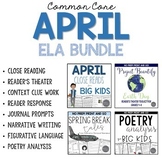Poetry Analysis Resource for Grades 4-8
- PDF
What educators are saying
Also included in
- Are you looking for the perfect poetry unit to engage all of your students from reluctant to enthusiastic about learning? This poetry analysis bundle features all 3 of my favorite poetry analysis resources!This Poetry Unit BUNDLE includes:Poetry Analysis for Big Kids Includes the following:• LessonPrice $13.00Original Price $19.00Save $6.00
- This incredible mega bundle includes a full year's worth of middle grade ELA resources at a significant discount. You get all of the tools you need to offer differentiation through a variety of reading, writing, speaking, listening and word work activities.WRITINGELA made Easy includes several resouPrice $139.00Original Price $268.50Save $129.50
- This collection of April ELA activities includes the perfect standards-based resources to engage your students throughout the month. Use these print-and-go resources to give your students practice reading to self, reading to someone, listening to reading, word work, and writing—all centered around tPrice $11.00Original Price $16.00Save $5.00
- This bundle of monthly ELA activities for middle school includes the perfect standards-based resources to engage your students throughout the school year. Use these print-and-go resources to give your students practice reading to self, reading to someone, listening to reading, word work, and writingPrice $105.00Original Price $167.50Save $62.50
Description
Poetry can feel overwhelming to teach and even more frustrating for students. I created this resource to help my students learn the poetic devices and demonstrate how we can use them to analyze poems. I've found this approach works well for boosting confidence, engagement, and understanding with my middle school students.
This PDF printable resource is broken down into 8 lessons, covering all of the poetic devices and finishing with analysis worksheets for students to demonstrate their understanding.
Here is a quick overview of how I use it in my classroom:.
Share the poetic devices and how to analyze poems worksheets. Use that foundation to help students develop their poetry notebooks. You can follow the detailed poetry lesson plans, go page by page from beginning to end, or hop around and focus on areas that need more clarification.
Student materials…
• a binder, notebook, or folder for each student
• a writing utensil
• colored pencils, pens, or markers to make note-taking and analyzing poems more colorful
Directions…
1. Use the Lesson Planning Pages
2. Give students copies to make their We HEART Poetry Notebook
3. Use the poetic device pages for student notes
4. Have students analyze the poems using the “How to Analyze a Poem” Notes and “Questions I Can Answer” Notes.
Students should write directly on the poems to become more thoughtful analyzers of poetry.
5. Navigate each of the poems with students to enhance their understanding of poetry, or allow students to work independently, with partners, in small groups to read and analyze each of the poems and then go over their analysis together in order to gauge their progress with understanding poetry.
This Poetry Analysis Unit includes:
• Lesson Planning Pages
• Poem Overview
• What is Poetry? Brainstorm
• What is Poetry? Definition
• Poetic Devices
• 12-Poetic Device Printables
• How To Analyze Poetry Printable
• Questions I Can Answer…
• Student Poetry Notebook
• What is Poetry? Brainstorm
• Poetic Devices and Notes for Students
• How To Analyze Poetry Notes
• Questions I Can Answer…Notes
• Poetry Reader Response Questions
• 10-Poems to Analyze
Poems included for analysis:
Dreams by Langston Hughes
A Dream Deferred by Langston Hughes
My Love And My Heart by Henry S. Leigh
O Captain! My Captain! by Walt Whitman
Stopping By Woods On A Snowy Evening by Robert Frost
Sweet! Sweet! by Louisa May Alcott
Nothing Gold Can Stay by Robert Frost
A Poison Tree by William Blake
Every Cat Has a Story by Naomi Shihab Nye
Spring Storm by Jim Wayne Miller
This is the perfect resource to EXCITE your students about poetry analysis! Here is a blog post that talks more about how and why I use this approach to teaching poetry.
All of My Poetry Units and Bundles:
- Poetry Unit Bundle
- Poetry Analysis for Big Kids
- Love That Dog Novel Study and Poetry Unit
- Hate That Cat Novel Study and Poetry Unit
*********************************************************************
More Great Ideas from Mrs. Beers Language Arts Classroom:
- Reader's Theater for BIG KIDS MEGA BUNDLE
- Editable ELA Word Wall for Middle School
- ELA Emergency Sub Plans Bundle Grades 4-8
- Wonder Novel Study Unit
- Context Clue Task Cards for Middle School
*********************************************************************
I would love your feedback on this product. Also, feel free to FOLLOW me so that you have the chance to find out about any new novel units I create as soon as they are posted.
HAPPY READING!









